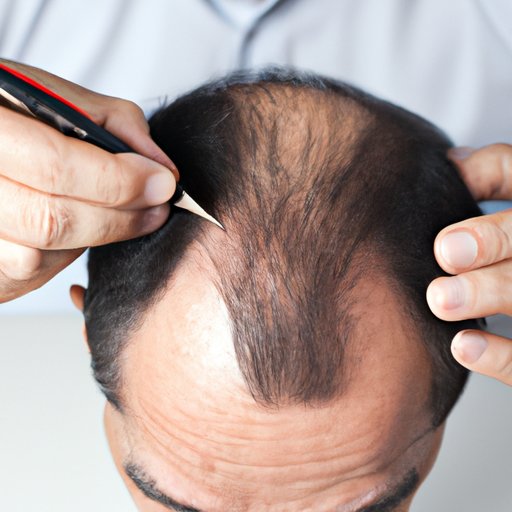Introduction
Hair thinning is a gradual process that can be difficult to detect without a careful examination. It can be caused by many different factors such as age, genetics, hormones, stress, or certain medical conditions. This article will explore the various signs of hair thinning and provide advice on when it is necessary to consult a professional.
Examine Scalp for Bald Spots and Thinning Patches
The most obvious signs of hair thinning are bald spots and patches on the scalp. Bald spots usually appear as circular or oval areas with no hair growth. Thinning patches are less distinct and may appear as thinner hair growth or patchy areas of the scalp.
If you notice any bald spots or thinning patches, it is important to seek professional help from a dermatologist or trichologist. They will be able to assess the cause of the hair thinning and recommend the best course of action.
Look for Increased Hair Loss when Washing, Brushing, and Styling
It is normal to lose an average of 50 to 100 strands of hair per day. However, if you are noticing more than this amount when washing, brushing, or styling your hair, it could be a sign of hair thinning. Pay attention to the amount of hair that falls out, as well as any areas of the scalp where the hair loss seems to be concentrated.
If you are experiencing increased hair loss, it is important to seek professional help to determine the cause. A doctor or trichologist will be able to assess the condition and recommend treatments or lifestyle modifications that may help.

Notice if the Diameter of Individual Hairs is Smaller than Usual
As hair thins, the diameter of individual hairs may get smaller. This can be difficult to detect without looking closely at each strand. To do this, part your hair into small sections and examine each strand. You may also want to use a magnifying glass to make it easier to see any changes in the thickness of your hair.
Smaller hairs can be a sign of hair thinning and may be caused by hormonal changes, nutritional deficiencies, or certain medications. If you notice any changes in the diameter of your individual hairs, it is important to seek professional help to determine the cause.

Check if There are Fewer Hairs in Your Brush or Comb after Styling
When styling your hair, take note of the number of hairs that remain in your brush or comb after you’ve finished. If there are noticeably fewer hairs than usual, it could be a sign of hair thinning. Pay attention to the areas of the scalp where the hair loss is most noticeable.
Hair thinning can be caused by many different factors, such as age, hormones, stress, or medical conditions. If you are experiencing significant hair loss, it is important to seek professional help to determine the cause and find the best treatment option.

Pay Attention to Any Changes in Hair Texture
Changes in hair texture can also be a sign of hair thinning. Look for any changes in the way your hair looks or feels. For example, if your hair has become brittle, dry, or wiry, it may be a sign of hair thinning.
Changes in hair texture can be caused by many different factors, including age, hormones, and medical conditions. If you notice any changes in the texture of your hair, it is important to seek professional help to determine the cause and find the best treatment option.
Measure Your Ponytail Circumference to Compare with Past Measurements
Measuring the circumference of your ponytail is another way to check for hair thinning. To do this, tie your hair into a ponytail and measure the circumference with a tape measure. Compare the measurement with previous measurements to look for any changes over time.
If you notice a decrease in the circumference of your ponytail over time, it may be a sign of hair thinning. It is important to seek professional help to determine the cause and find the best treatment option.
Consult a Professional Trichologist for an Accurate Assessment
If you are concerned about hair thinning, it is important to consult a professional trichologist. A trichologist is a specialist in the diagnosis and treatment of hair and scalp problems. They will be able to assess your condition and provide advice on the best course of action.
When looking for a qualified trichologist, make sure to research their credentials and experience. It is also important to ask for references from other patients who have had successful results.
Conclusion
Hair thinning can be a difficult process to detect without a careful examination. This article has explored the various signs of hair thinning, such as bald spots and patches on the scalp, increased hair loss when washing, brushing, or styling, smaller hairs, fewer hairs in a brush or comb, and changes in texture. It is important to seek professional help if you are experiencing any of these symptoms.
Measuring the circumference of your ponytail can also help to detect hair thinning. If you are concerned about hair thinning, it is important to consult a qualified trichologist for an accurate assessment. They will be able to assess your condition and provide advice on the best course of action.


